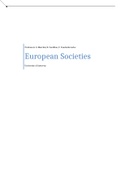Professors: S. Marchal, B. Cantillon, F. Vandenbroucke
European Societies
University of Antwerp
,Class contents and schedule
The 3 ECTS course "European Societies" seeks to initiate students to Europe as a political, economic
and social entity, as well as a project to bring about, in the words of the Treaty of Rome, 'an ever
closer union among the peoples of Europe'. The course starts with the emergence and development
of the European project after the Second World War and it introduces students to the workings of
the key European institutions. The course seeks to make students aware of the inherent challenges
to (purposeful) socio-economic integration in the face of Europe's massive economic, social, cultural
and institutional diversity. At the same time, students will be made aware that much has been
achieved. Yet despite marked progress, and indeed remarkable upward convergence on a number of
fronts - for example living standards or equal rights - the social and economic challenges facing
Europe remain formidable. We will consider alternative ways forward, at the national and supra-
national level.
Date Lec. Title Speaker Compulsory reading
10/2 1 The European Ive Marx European Commission (2017). Europe in 12 lessons. Luxembourg:
project: some of the Publications Office of the European Union;
good, the bad and Slides
the ugly
17/2 2 The European Peter Bursens “Europe in 12 lessons” (supra);
Institutions Slides
24/2 3 The foundations of Bea Cantillon Anderson, Karen M. (2015). Social Policy in the European Union.
social subsidiarity Macmillan International Higher Education: Chapters 2 and 3
(“Explaining Social policy-making in the EU” and “Social Policy and
Multilevel Governance”);
Slides
02/3 4 Europe as an Ive Marx Usherwood, S. & Pindar, J. (2018), Single market, single currency. In
economic entity Usherwood, S. & Pindar, J. The European Union: A very short
Introduction, Oxford University Press, pp. 56-68;
Staab, A. (2013), The Single Market and Competition (chapter 9) and
Economic and Monetary Union (EMU) (chapter 12). In Staab, A., The
European Union explained, 3rd edition, Indiana University Press;
Slides
09/3 5 The layered welfare Bea Cantillon Cantillon, B. The European Pillar of Social Rights: ten arguments for
state and the prioritising principle 14 on minimum incomes:
European social http://www.euvisions.eu/ten-arguments-european-pillar-of-social-
acquis = what next ? rights-principle-minimum-income/
https://ec.europa.eu/eurostat/statistics-explained/index.php/
Living_conditions_in_Europe_-_poverty_and_social_exclusion
Slides
23/3 6 The European Social Johanna Greiss Greiss, J., Cantillon, B., Marchal, S. & Penne, T. (2019). Europe as
Funds: Instruments agent that fills the gaps? The case of FEAD. CSB Working Paper Series,
to bypass or to No. 19.03. Antwerp: University of Antwerp;
strengthen national
welfare states? Delanghe, H. (2019). The European Social Fund. Een Europees
Perspectief op Solidariteit. Het Europees Sociaal Fonds in het Licht van
de Nationale Armoedebestrijding, chapter 6, translation of Dutch
original. Unpublished master’s thesis, University of Antwerp, Belgium;
Slides
27/4 7 Towards a European Frank Vandenbroucke, F. (2020). Solidarity through Redistribution and
Social Union Vandenbroucke Insurance of Incomes: The EU As Support, Guide, Guarantor or
Provider?. AMember Statesterdam Centre for European Studies
Research Paper, (2020/01);
Slides
04/5 8 Migration and the Ive Marx Mussche, N., Corluy, V., & Marx, I. (2018). How posting shapes a
European labour hybrid single European labour market. European Journal of Industrial
market(s) Relations, 24(2), 113-127;
Slides
11/5 9 Towards a European Discussion
Solidarity?
2
,3
, CLASS 1: United in diversity – the European product in the making
Contents:
How did the European Union project emerge?
What have been its major accomplishments?
What are large challenges?
Is there a fundamental design flaw in the European Union project?
The European Union
The EU is an economic and political Union that consists of 27 member states.
It has its own institutions, governing bodies and political cycle.
It’s a mixture of intergovernmental and supranational policy making.
The EU = A system of multilevel governance
Three sources of binding legal provisions: treaties, directives and regulations, doctrines.
o Primary legislation: Treaties (verdragen)
o Secondary legislation: Directives and regulations + CJEU rulings (richtlijnen en
regelgeving)
o Doctrines (verzameling leerstellingen) developed by CJEU from early 1960s:
Direct effect: EU law is directly enforceable in national courts
Supremacy: supremacy of EU law over national law
Key principles of the EU
Subsidiarity The EU should only deal with a subject when action at European level is
more efficient than at national or regional levels.
Conferral Only those competences conferred upon the EU by the Treaties.
Proportionality The content and form of the action does not exceed what is necessary to
achieve the objectives set by the Treaties
4




